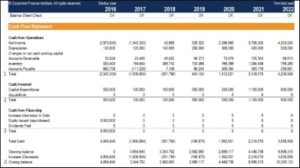
By doing so, it helps in detecting any discrepancies between the company’s records and the bank statement, thereby ensuring the accuracy of financial data. This process plays a crucial role in maintaining the integrity of financial data and safeguarding against discrepancies. By reconciling transactions, users can confidently rely on the accuracy of their financial reports, ensuring that each transaction has been properly accounted for and is consistent with the bank statement. This crucial feature can be accessed by navigating to the ‘Banking’ menu and selecting the ‘Reconcile’ option. Once within the reconcile window, users can input the bank statement date, ending balance, and begin matching transactions. The significance of this phase lies in its ability to identify any discrepancies or errors, providing a clear overview of the company’s financial status.
How to Mark a Transaction as Reconciled in QuickBooks Online?
- Any discrepancies should be thoroughly investigated and adjusted in QuickBooks to reconcile the balances accurately.
- Using this method, all adjustments, service fees, and interest you enter during the reconciliation process will apply to the year in which those transactions occurred.
- We’ll provide you with a quick reconciliation tutorial, highlight the steps necessary to use this handy feature, and give you a heads-up on what to look out for when using the reconciliation feature.
- The significance of this phase lies in its ability to identify any discrepancies or errors, providing a clear overview of the company’s financial status.
- Its advantage lies in its ability to streamline and enhance the account reconciliation process, thereby contributing to the overall financial health of an organization.
This crucial step requires attention to detail and accuracy to certify that all entries, including deposits, withdrawals, and other financial activities, are correctly reflected and reconciled. After confirming the match between the records and the bank statement, it is essential to review any discrepancies and make necessary adjustments. Reconciling in QuickBooks Desktop involves a set of structured procedures to ensure that the financial records accurately correspond with the bank statement, reflecting the precise financial position of the business. The reconciliation process is concluded by affirming that the closing balances match, signifying the successful alignment of the financial records with the official bank statements. This finalization stage is vital for ensuring the accuracy and integrity of the financial data, providing a clear overview of the company’s financial position and allowing for informed decision-making. Accessing the reconcile window in QuickBooks Desktop is the initial step in the reconciliation process, enabling users to match the financial records with the bank statement and ensure accuracy.
By adjusting transactions, users can ensure that financial statements and their utmost importance to users their financial data aligns with the actual bank activity, minimizing errors and enhancing the overall reliability of the financial statements. Reconciling previous months in QuickBooks Online involves the process of retroactively matching the financial records with the bank statements for specific past periods to ensure comprehensive financial accuracy. This step involves accessing the ‘Reconcile’ feature, selecting the appropriate account, and entering the closing balance provided by the bank.

Once this is completed, any difference between the two balances will be highlighted on the reconciliation page. If you have very limited transactions for expenses questions the month, your QuickBooks Online and bank statement balances may match, which is rare but would indicate that further reconciliation is not needed. While connecting your bank account directly to an accounting software application such as QuickBooks Online makes it easier to track and match transactions, you still need to complete the reconciliation process.
This process involves meticulously reviewing each transaction entry in QuickBooks and cross-referencing it with the corresponding entry in the bank statement. By performing this comparison, discrepancies such as missing transactions, duplicate entries, or incorrect amounts can be readily identified. This not only helps in maintaining accurate financial records but also serves as a crucial reconciliation step to ensure that the company’s books reflect the true financial position. This process is crucial for ensuring that all transactions recorded in the accounting system align with the actual activity in the bank account.
Step 2: Prepare for the reconciliation
To get started reconciling your accounts, just follow this easy three-step process. For example, if your bank regularly charges you a service fee each month, it will not be posted into your general ledger, leaving you with an inaccurate balance. Assuming there are no other outstanding transactions that need to be posted, once you record the bank service fee in your general ledger, your bank balance and general ledger balance should match. Make sure you enter all transactions for the bank statement period you plan to reconcile.
Gathering the bank statement and transactions is the initial step in reconciling a bank statement in QuickBooks, enabling the comprehensive matching of financial data with the official bank records. Entering the ending balance in QuickBooks Desktop is a what is workers’ compensation or workman’s comp critical step in the reconciliation process, ensuring that the financial records match the closing balance of the bank statement accurately. Reconciling in QuickBooks Online involves several key steps to ensure that the financial records align with the bank statement and reflect accurate transactional data. If you have connected your bank accounts with QuickBooks Online, it’s important that all of your downloaded transactions have been matched with recorded expenses.
Step 5: Addressing Discrepancies
This process directly impacts the balance sheet accounts, transactions, and banking activities. It provides a clear and accurate picture of the company’s financial health, enabling informed decision-making. Whether you’re using QuickBooks Online or QuickBooks Desktop, understanding the process of reconciliation is crucial for ensuring the accuracy and integrity of your financial records. In this comprehensive guide, we’ll walk you through the step-by-step process of reconciling your accounts, including bank statements and balance sheet accounts. This process involves comparing the transactions entered into QuickBooks Online with the bank statement to pinpoint any inconsistencies. By meticulously reviewing each transaction, users can detect potential errors such as duplicates, missing entries, or incorrect categorizations.
Adjustments may be necessary to rectify any inconsistencies and ensure that the financial records accurately reflect the actual bank activity. This process is crucial for maintaining accurate financial records and ensuring that there are no discrepancies in the company’s books. It entails reviewing each transaction, comparing it with the corresponding bank statement entry, and making any necessary adjustments to ensure the accuracy of the records. This process is crucial in achieving reconciliation accuracy, as it involves reviewing and making necessary modifications to account for any discrepancies.
In this comprehensive guide, we’ll walk you through the step-by-step process of reconciling accounts in QuickBooks, ensuring your financial accuracy and peace of mind. This is a crucial step in the accounting process as it helps in identifying and rectifying any discrepancies, errors, or missing transactions that may have occurred during the earlier months. By comparing the transactions recorded in QuickBooks with the actual bank statements, businesses can ensure that their financial records accurately reflect the true state of their accounts from previous months.

